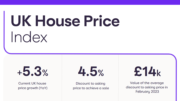UK homeowners are ending October on mixed fortunes, as new research reveals a national house price rise of 2.8% since last Halloween-though nearly one in four areas has seen local values fall. For landlords, these regional dips could spell a timely buying opportunity before the Autumn Budget.
Regional gains show resilience beyond London
According to The Property DriveBuy, which analysed Government UK House Price Index data from October 2024 to August 2025, the North East leads this year’s growth charts with a 5.2% rise in average prices. By contrast, London has seen a minimal 0.8% lift-suggesting investors in the capital are contending with a sluggish recovery compared to regions offering stronger rental yields.
Property analysts say these trends reflect the broader shift towards affordability-driven relocations. “The market has delivered far more treats than tricks this year,” said Steve Foreman, CEO of The Property DriveBuy. “Prices are up across most of the UK, but performance remains hyper-local. Some areas have cooled, creating chances for buyers willing to look beyond postcode prestige.”
For landlords seeking returns, the North East, North West, and parts of the Midlands continue to offer a better yield-to-cost balance than the capital-particularly as mortgage rates stabilise heading into winter.
London and Welsh markets lead the Halloween price falls
The capital saw several boroughs endure chilling price corrections over the past year. Westminster recorded a 13.2% annual drop-the steepest nationwide-followed by Kensington and Chelsea at 11.8%. Tower Hamlets, Brent, and Hammersmith and Fulham also feature among the worst performers, with prices down between 4.7% and 7.7%.
Outside London, Wales has seen its fair share of frights. Ceredigion experienced a 9.5% drop, and Merthyr Tydfil followed close behind at 9.4%. For property investors, these sharp falls could mark the turning point before values begin to recover in 2026, especially if demand rebounds as expected once inflation eases.
These shifts underscore how localised price pressures are becoming. As Foreman notes, “The worst of these falls are not confined to one corner of the map… London, Wales, the South East, and parts of Scotland all feature among the biggest reductions.”
Buy-to-let opportunities before the Autumn Budget
For many landlords, these regional price dips could provide a rare entry point in an otherwise resilient housing market. With average rents continuing to outpace inflation, falling purchase prices in select areas may strengthen yields in early 2026.
Investors using location-based property tools like The Property DriveBuy app can identify on-the-ground opportunities in real time. As Foreman suggests, “While taking the kids trick-or-treating, landlords might also keep an eye out for a real Halloween treat-a discounted property that’s been overlooked by the wider market.”
For those considering portfolio expansion, now may be the moment to explore re-financing or selective acquisitions before potential tax or lending changes are announced in the upcoming Budget.
Editor’s view
The UK property market continues to show remarkable resilience-2.8% annual growth is no small feat given higher interest rates and policy uncertainty. Yet the sharp local dips reveal where value can still be found. For professional landlords, this uneven landscape could be the most attractive in years-if approached strategically and with regional insight.
Author: Editorial team - UK landlord & buy-to-let news, policy, and finance.
Published: 31 October 2025
Sources: The Property DriveBuy, UK House Price Index (Gov), ONS
Related reading: UK rent growth slows again as house prices climb to £269,000








